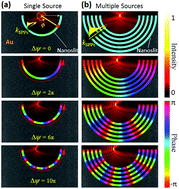On-chip discrimination of orbital angular momentum of light with plasmonic nanoslits†
Abstract
The orbital angular momentum (OAM) of light can be taken as an independent and orthogonal degree of freedom for multiplexing in an optical communication system, potentially improving the system capacity to hundreds of Tbits per second. The high compactness and miniaturization of devices required for optical communications impose strict requirements on discriminating OAM modes of light at a small (micro- or even nano-meter) scale for demultiplexing; these requirements represent a challenge for traditional OAM sorting strategies. Here, we propose a semi-ring plasmonic nanoslit to directly and spatially sort various OAM modes of light into ∼120 nm-spaced mode intervals on the metallic surface. Making use of the constructive interference of a helical-phase modulated surface wave excited by a vortex beam, this on-chip interval can be stably demonstrated both theoretically and experimentally with a quasi-linear dependence on the plasmonic wavelength. Furthermore, its immunity to semi-ring geometry (i.e., the radius and number of rings) is verified by simulations. As a result, OAM discriminating is guaranteed by this stable sorting function. This technique shows a viable solution to discriminate the OAM of light at the nano-scale and might lead to broad benefits across the fields of optical communications, plasmonic physics and singular optics.


 Please wait while we load your content...
Please wait while we load your content...